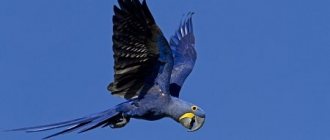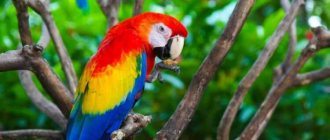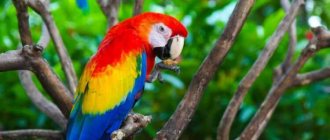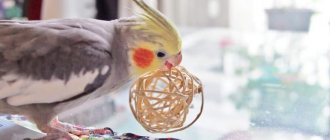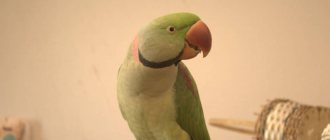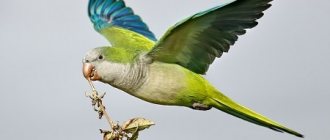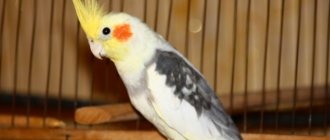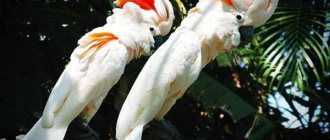The most spectacular macaw parrot in the world deserves an excellent rating: the most beautiful, smartest, rarest, most expensive and largest of the representatives of the parrot family. The elite bird is protected by law, while several species are endangered, and the blue macaw lives and breeds only in captivity. The article contains basic information about the noble macaw parrot: where it lives and what it looks like, why it is interesting and whether it is possible to keep an exotic pet at home.
Hyacinth macaw
Appearance
The Ara parrot is brightness, contrast, multicolor. The classification of birds is based on color features. The plumage of these beautiful parrots contains the richest shades: yellow, red, blue, green. Only the macaw does not have white and black as its main colors. These colors are occasionally present on the body of birds: on the facial mask, chin, crown of the head, and in patterns on the cheeks.
In addition to the beauty of its plumage, the macaw is famous for its large size. There are giant individuals, such as the red macaw, the green-winged macaw, and the hyacinth macaw. They grow up to a meter in length and weigh 1.5 kg. The wide wingspan and long stepped tail make the bird look simply incredible. There are also small varieties: dwarf or “mini” macaws (blue-fronted, soldier, yellow-necked). They also deserve attention, although not so grandiose.
Red Macaw
Other features of the macaw parrot:
- large beak with a sharp tip, rounded and laterally compressed;
- unfeathered areas of skin between the beak and eyes;
- highly elongated wings, reaching a span of 80 cm.
You can admire the colorful appearance of the gorgeous bird in the photo.
Description
— Advertising —
The genus of macaws is a large-bodied feathered bird from the parrot family, which is characterized by brightly colored plumage from blue to red. It is worth noting that the classification of Macaw parrots is largely based on color.
Of the common characteristics that stand out among all representatives of the genus, the first is a large rounded beak with a steep tip, which is compressed on both sides. Ornithologists say that the beak of this animal is the strongest on earth.
— Advertising —
The second common characteristic is bare patches of skin around the eyes and cheeks on the face. Short colored feathers are located in such bare places, but not all types of macaws have them. Third, the wings of Macaw parrots become very elongated towards the end. The tail is bright and wedge-shaped. You can clearly see the above characteristics in the photo of the macaw parrot.
Habitat
The macaw parrot lives in South America: the northern and central parts of the continent, in the Amazon River basin, on the west coast and in the foothills of the Andes. Each species has its own habitat: some parrots live in the tropics, others in humid equatorial forests, and others in mountainous areas. Some representatives of the genus Ara prefer dry steppe areas or cool ocean coasts.
Character and behavior
In nature, macaws lead a gregarious lifestyle. There is no leader within the group, but there are separate married couples. A flock can fly from place to place, covering long distances. By nature, macaws are quite calm and peaceful, but on occasion they can defend territory and protect offspring. The chicks live with their parents for several years until they reach sexual maturity and start their own families.
This is interesting! Macaws are monogamous and are faithful to their partner throughout their lives. When one parrot of a pair dies, the second continues to sit nearby. Such devotion reflects poorly on birds: a yearning parrot becomes easy prey for poachers.
The large macaw parrot has strong paws with strong claws. The bird uses its limbs with amazing dexterity:
- easily moves along a tree trunk;
- grasping the branches, hanging upside down;
- plucks fruits from the tree with its paw and holds fruits while eating;
- tears up the ground in search of roots;
- builds a nest in a hollow.
All manipulations also involve a strong beak, which replaces the bird’s hand. The feathered giant freely cracks the hardest nuts, bites branches, and tears off bark to build a nest. With a sensitive tongue, the parrot determines the suitability of the fruit for food, easily selects the most delicious parts of the shoots, and takes out the seeds.
Intelligence
The macaw is not only a beautiful but also a very smart parrot. By nature, he inherited remarkable intelligence, which helps the bird survive in natural conditions and adapt to life in captivity. In a flock, parrots take care of each other, give signals of danger, and search for food together. At the right moment they can become quiet in order to avoid an attack.
When kept at home, the macaw parrot behaves in any situation as if it were the master of the situation. He knows how to get out of difficult conditions and does not allow himself to be commanded. With proper upbringing, it is easy to come to an agreement with a macaw. If you start taming and training in a timely manner, you can raise an excellent trickster, ready to follow commands and solve logical problems.
Macaws have the ability to speak. This is not the kind of meaningful conversation that a gray parrot can conduct, but quite distinct phrases and words. Some individuals pronounce memorized words to the point, and it seems that they use them according to the meaning of the conversation. Birds can “sing” (transmit a melody with their voice) and dance to the beat of the music. This confirms that their level of intelligence is quite high.
Kinds
Of the 15 species of macaw parrots that exist today, several representatives deserve special attention. These birds are distinguished by their bright colors, large sizes, and level of intelligence. They are highly valued in their homeland, as well as throughout the world.
Blue-yellow
This parrot has blue feathers on the back of its body and yellow feathers on the front. In flight, the two-colored ararauna parrot (translated from Latin as blue gold) looks yellow below and blue above. It is also called the yellow macaw. The forehead is green, the beard is black with greenish splashes. The white face mask is dotted with black stripes, which form a unique pattern, like human fingerprints. The eyes are outlined in black, the iris is transparent yellow, and the pupils are small. The beak is black, flattened laterally. Very strong gray paws with long toes and claws.
Blue and yellow macaw
It is considered one of the most beautiful and largest macaws. The body weight of an adult bird is 1-1.4 kg, the length reaches 80-90 cm, half of which is the wedge-shaped tail. The wingspan is about 80 cm. The parrot lives in the tropical forests of South America: it occupies territories from Brazil to Panama. Attached to a specific place, does not migrate, stays in a flock.
Green-winged macaw
It is similar in size to the blue-and-yellow macaw, even slightly larger. The plumage has three colors:
- red head, neck, abdomen, underside of wings, shoulders and part of the tail;
- blue wings and tail;
- green areas in the center of the outer side of the wings. Although these areas occupy a small percentage of the total mass of feathers, it was the green color on the wings that gave the parrot its name.
Green-winged Macaw
The face mask is devoid of feathers and has a red wave pattern running across it. The beak is two-colored: the upper process is pinkish-white with a black tip, the lower one is completely black. Males have yellow eyes, females have brown eyes. The Green-winged Macaw resembles the Red Macaw in appearance, but is distinguished by the absence of yellow color.
Green-winged macaw
The parrot's geographic homeland is also the continent of South America; the list of countries includes Venezuela, Bolivia, Colombia, Peru and others. Large birds live in small groups and prefer flat terrain and dense forests.
Red Macaw
The red macaw has several names: arakanga (climbing bird), macao, red and blue macaw. In the parrot family, the species “red macaw” is named, as is customary, by its accent shade. If you look at a parrot from the bottom up, the color will be solid red. Looking at the macaw from the back, we will see the red head, neck and back, as well as the small wing coverts. The central areas of the wings are yellow, but the long flight feathers and tail feathers are blue. The feathers in the center of the tail and on its underside are red. The beak is the same as that of a green-winged macaw.
Red Macaw (Macao)
On a note! The red macaw has a completely white face mask, unlike the blue-and-yellow and green-winged species. The skin on the cheeks gathers in folds, but there are no feathers on them.
One of the largest representatives of the family weighs approximately 1.5 kg, the length of the body and tail separately is 45-50 cm, from the beak to the tip of the tail is almost a meter. Perhaps the macaw itself is not so large, but its wide wings, long tail and strong build add impressiveness to its dimensions.
Macau's habitat is Central America, South America (Amazonian basin). Their permanent place of residence is tropical forests. Like representatives of other species of macaws, red and blue macaws do not like crowding, so they stay in small groups.
Hyacinth macaw
The blue macaw is named hyacinth due to the rich, juicy hue of the hyacinth flower. The parrot's body is covered with bright blue feathers, but the underside of the wings and tail are graphite. The noble blue color is diluted with four contrasting dots: the eyes are outlined in yellow circles and there are two stripes of the same color around the mandible. There are no unfeathered areas on the cheeks, unlike other macaw species. The beak and iris of the eyes are completely black.
Hyacinth macaw
The Hyacinth Macaw is incredibly beautiful, and it is also the largest among the parrots of this species. The parrot can be more than a meter in length (about half is accounted for by its narrow tail), and its weight exceeds one and a half kilograms.
Inhabits palm groves of Brazil, Bolivia and Paraguay. The owner of a beautiful appearance and gigantic size is on the list of birds whose numbers are steadily declining.
Blue-fronted Lesser Macaw
The dwarf macaw is the smallest representative of its genus. It grows up to 35 cm, its weight is comparable to Amazon parrots - only 170 g. It is called blue-fronted because of the color of the feathers covering the front of the head from the beak to the top of the head. The bird also has another name - the red-shouldered macaw. This name is derived from the red areas on the folds of the wings.
Blue-fronted Macaw
The body is covered with green feathers, the undertail is yellowish, and there are yellow and bluish shades on the wings. From the eyes to the beak and on the bridge of the nose there is an unfeathered area, the skin is white with dotted patches of black fluff. The beak is black below, light beige above, and the tip is dark. The eyes are brown, large, expressive.
The Lesser Blue-fronted Macaw is found in tropical areas of South America: Brazil, Suriname, Guiana and Venezuela.
Lesser Soldier's Macaw
The South American ara militaris (lat.) received its name because of its camouflage coloring, reminiscent of khaki: olive-green feathers with a dusty tint. The red spot on the forehead adds similarity to the appearance of a soldier, as if the parrot is wearing an army beret. The feathers on the back surface of the body are colored in a protective grass color with gray spots, and on the belly, the underside of the wings and the throat they are brown-olive.
Bright color accents - red forehead, blue flight feathers, blue rump, brick tail with a blue border. Around the eyes and on the cheeks there is folded white skin, lined with a black pattern.
Lesser Soldier's Macaw
Did you know? When a macaw experiences fear, excitement and other emotions, its white cheeks turn red. This feature is characteristic of every parrot of the genus Ara with an unfeathered facial mask.
The weight category of the soldier's macaw is average - the bird grows up to 60 cm including the tail, and its weight is in the range of 800-900 g. The appearance of representatives of both sexes is almost the same, but females are slightly inferior in size.
Red-backed Macaw
The parrot does not look as bright as large species of macaw, but its colors are interesting in their own way. The color scheme of the plumage is varied: there are warm shades of green (outer side of the wings, neck, chest), framed by blue flight and tail feathers, diluted with red accents (back, lower abdomen, forehead). The undertail is dirty yellow. The short, lush feathers on the crown and back of the head are dark blue with a metallic sheen.
Red-backed Macaw
The areas from the mandible to the brown eyes are almost devoid of feathers, the skin there is white or yellowish with thin black stripes. The beak is black or dark gray, the legs are ashen. Females differ from males in the smaller size of the red spot on the forehead. The red-backed macaw appears large due to its long tail, but in terms of its dimensions it can hardly be classified as a large parrot. The bird's weight is only 300 g, body length is approximately 45 cm, tail - 20 cm. Habitat - Paraguay and eastern Brazil.
Yellow-necked Macaw
The main feature of this parrot is the yellow “collar” located on the back of the neck. In males this stripe is wider and brighter than in females.
Description of the Yellow-necked Macaw:
- emerald green plumage;
- the edges of the wings are blue;
- tricolor tail (green on top, brown in the middle, blue at the tip);
- blue-black forehead and the same beard;
- the underside of the tail and wings is yellow;
- cheeks white with a wave pattern;
- eyes amber-brown.
Yellow-necked macaw
The yellow-necked macaw is a “mini-macaw”, its size does not exceed 40 cm, and its weight is 300 g. The birds live in different areas of Latin America: populations of yellow-necked macaws are found in the jungle, open savannas, and woodlands.
Occasionally, representatives of the species can be observed in mountainous areas. Habitat: eastern Bolivia, Brazil, northern Paraguay and Argentina.
What parrots can talk?
The king of talking parrots is usually a breed of African gray parrot (Grey). They developed mental abilities many hundreds of years ago that are now superior to most other birds. There is a downside to them: Grays are the most socially demanding. They really need constant communication and interaction with other animals or people.
The next best conversationalists are the Amazonians from South and Central America. Unlike gray parrots, which easily learn new words, Amazons manage this at a slower speed. Some people learn to speak only by the age of two.
Small budgies can also talk very well. They seem to have a special gift, as do the Kalita, Corella and Loris parrots.
The macaw, although the largest bird among the parrots, is not very talkative. In the study, none of the 51 macaws were able to say more than 10 words. Macaws tend to have a rather hoarse voice.
Cockatoos can also learn to speak. But, like macaws, they usually have a limited vocabulary. But unlike macaws, cockatoos have rather sweet, soft voices.
The total list of “colloquiality” looks like this:
- Jaco.
- Amazon.
- Budgerigars.
- Kalita.
- Korela.
- Laurie.
- Cockatoo.
- Macaw.
Amazon
Amazons are the most popular species among parrots, medium-sized and quite talkative. They are quite noisy, playful and talkative - many sing very beautifully. Male Amazons try in every possible way to force the female to pay attention to them, showing her a whole performance.
Amazons are called one of the best interlocutors in the bird world. They especially love music and singing. Amazons can sing as if the performer himself was singing live. Amazons can learn to speak many words and phrases and imitate sounds.
The Amazon parrot can also be noisy, especially when it wants attention. It can scream loudly, and some make a repetitive buzzing sound when they want something. Some Amazons make a slightly high-pitched sound to express delight when they eat their favorite treat. Does the bird understand this? Yes, they understand what they are doing.
Macaw
Macaws are large in size and have bright colors... Although their large beaks may look intimidating, a well socialized macaw can be a friendly and affectionate companion.
Macaws are known as giants of the bird world. The macaw is the longest parrot, with a head to tail length of almost 40 inches. Macaws have long tail feathers as well as large beaks.
The macaw is native to southern North America (Mexico), as well as Central America and South America. Evidence shows that the Caribbean islands also had native species of macaws that are now extinct. They live in tropical forests, as well as grasslands and grassy forest areas. Macaws and other species native to the Amazon eat clay, which researchers say allows the parrots to neutralize toxins found in some of the foods they eat in the wild.
Large macaws have similar vocal abilities and their calls can be quite loud and ear-piercing. A potential macaw owner should take into account the loud sound of the macaw, especially if he or she lives in an apartment and neighbors. Macaws can be taught to talk and can whistle or imitate sounds and noises they hear inside and outside the home.
Wavy
Budgerigars can live between seven and fifteen years, although on average they live less than seven due to abuse, accidents, or owners' lack of knowledge about proper bird care.
It is recognized that this small bird is often considered an ideal pet because they are small and inexpensive. Budgerigars are also susceptible to obesity, liver tumors, foot diseases, and intestinal parasites.
The budgerigar is native to Australia, where it still lives on grasslands in large budgerigar flocks. They are mostly blue or green in color. This is the bird that we see in all pet stores today. How much does a budgerigar cost? Up to several thousand rubles.
Wild budgies are found in large flocks that are always searching for water, which is limited in the bush, a habitat that makes up much of the budgie's natural range. They breed during the rainy season, when water and food are abundant, and nest in hollowed out trees or tree branches. They can be a nuisance for farmers, and are especially dangerous for grain crops.
Budgerigar breeds are optimal talking birds that can easily learn words, phrases, and whistles. One budgerigar is known to repeat more than 1,700 words! His name was Pak.
Jaco
Before choosing a parrot, you need to know that the ability of grays to exactly the opposite to repeat certain sounds and human speech makes them unique birds. Parrot owners often say that their birds often chat with them and can feel their mood at one time or another. They are considered the smartest birds.
Grays are very popular because they are considered to be the most capable among their relatives. They are known all over the world. Perhaps the oldest species that people have been able to domesticate. Beauty, intelligence and charisma are what makes a bird popular.
At first glance, the Gray Gray is an ordinary medium-sized gray bird, similar to a pigeon, but there are species with a bright red tail and stunning iridescent plumage, and there is white color in the feathers.
How much are? Sometimes the cost of the smartest parrots fluctuates around three hundred thousand rubles.
Cockatoo
Ready to be around people all day long and chat incessantly. This is a loving but demanding bird.
Cockatoos stand out from other parrot species with their dramatic crested feathers, dusty colored feathers and varying shades of white, pink, gray and black. They are very similar to children aged two years in their behavior and emotions.
Usually quite loud if someone decides to pay attention to them. They almost organize a concert, but the only drawback is that the cockatoos only learn a few phrases and words.
Kalita
It's a shame that the Kalita is banned in some cities and states because this parrot's speaking abilities and intelligence rival the much more expensive African and Amazonian parrots.
The Calita parrot comes to us from South America and is one of the most popular species of its size due to its availability, low cost and outstanding ability to imitate. This colorful, resourceful, 12-inch bird has been able to establish large wild flocks from South Florida to the Northeast and Midwest, making them a charming addition to the landscape of these areas, although many residents consider them to be crop pests.
People with noise sensitivity should think twice about bringing this bird home. They will wake up the deepest sleeper and may disturb the neighbors. On the plus side, these birds are wonderful talkers, capable of learning many words and phrases, especially if kept as one bird. You can choose a Kalita, but you should know that they are also highly trainable and can learn tricks when motivated by food or praise. Kalitas can be affectionate and tame. They can often be purchased untamed and will become habituated quickly.
Corella
Cockatiels also learn human speech. These are very active birds that cannot sit still.
Cockatiels are native to the forests of Yamdena, Larat and Selaru, all islands in the Tanimbar archipelago in Indonesia. Cockatiels are very smart and are especially good at figuring out how to open cage doors. They will open virtually any cage door.
A 2013 Oxford University study found that Goffin could solve complex mechanical problems by mastering a series of locks one after another. Ten untrained parrots stood in front of a puzzle box with a nut behind a transparent door that was secured by a series of five interlocking devices.
To get to the nut, Corella had to first remove the pin, then the screw, then the bolt, then turn the wheel 90 degrees, and then slide the latch to the side. Surprisingly, the birds coped with this problem without much difficulty.
The cockatiel will make noise, especially if he wants your attention. They can learn a significant portion of words and phrases. Like many others, cockatiels love to dance to music.
Laurie
Lori is not a shy type. The rainbow loris is a playful and enthusiastic species of the bird world that loves having its owner nearby.
Loris are one of the most colorful parrot species and they have a unique brush-like tongue that allows them to remove pollen and nectar from flower flowers. They use nectar as a major part of their diet. The homeland is Australia.
If rainbow lorises are left alone too often, they will develop serious behavioral disorders. Because your feathered friend is active and intelligent, she will usually only bite out of excitement or fear (usually from being put back in her cage!).
Lorises can learn to talk, but they tend to express themselves with a high-pitched, high-pitched squeal that can attract the attention of neighbors who live nearby.
Extinct species of macaw
The scientific classification previously contained more than two dozen species of macaw parrot, several are now considered extinct. One species continues to reproduce slowly in captivity, but can no longer be found in the wild.
Guadalupe macaw
It was discovered by naturalists in the 18th century on the islands of Guadeloupe and Martinique. In appearance it resembled a grandiose red macaw, only much smaller in size. The Guadalupe Macaw's tail was completely red, and the feathers on its wings were red and yellow. The cause of the extinction is unknown. After 1760, representatives of the species were seen extremely rarely, and soon disappeared completely.
Guadalupe macaw
Yellow-green Jamaican macaw
An extinct representative of the fauna of the island of Jamaica was preserved only in a drawing created by naturalist F.G. Gosse. We can draw conclusions about what the parrot was like: the body is green, the wings are painted the same color, and there are blue feathers on their edges. The head is red, the tail is stepped with transitions from green to red and blue. Extinct in the 19th century.
Yellow-green Jamaican macaw
Red Jamaican Macaw
A related species of the Cuban macaw. Lived on the island of Jamaica, a description is available from the works of the naturalist Gosse: a yellow trail of feathers stretches from the forehead to the middle of the neck, turning into a red back. The main color of the plumage is red, the wings are red-blue, the tail is yellow-red. The face mask has white spots around the eyes and near the beak.
Red Jamaican Macaw
Cuban macaw
The appearance of the parrot was very bright: the throat, body, crown and shoulders were red, the neck was yellow, the tail was red and blue, and the tail feathers were ultramarine. Body length is approximately 50 cm. The tricolored Cuban macaw is named according to its habitat - the island of Cuba. Until 1800, it bred quietly, but when deforestation began for plantations, the peaceful existence of local birds was disrupted. The number of individuals began to decline. At the end of the 19th century, the species ceased to exist.
Cuban macaw
Virginia macaw
Fossil species of parrots. The remains were found on the island of Santa Cruz in the Caribbean Sea. Extinct in the fourth century AD. For obvious reasons, there is no description of the bird. Presumably, the extinction was caused by changes in habitats and loss of the natural environment.
Blue Macaw
In the genus Ara, the Spix's macaw parrot is not yet considered extinct, but representatives of the species have long disappeared from the wild, only those living in captivity have survived. The reasons for the extinction were the loss of natural landscapes due to deforestation, poaching and proximity to aggressive bee species.
Blue Macaw
The color of the bird is dominated by different shades of blue: light blue on the head, azure on the wings, ash blue on the neck, dark blue on the tail, cornflower blue in separate patches. A white strip of skin runs from eye to eye across the bridge of the nose, forming something like “glasses.” The short feathers on the head can puff up like a crest if the parrot is alarmed by something.
Currently, there is an international program to protect and increase the number of the blue macaw species. From year to year, more and more chicks appear in nurseries and reserves, and there is hope to preserve the endangered species.
Features and habitat of the macaw parrot
Macaw parrot , also known as Macau, is a beautiful large bird belonging to the parrot family. The largest among other species of parrots, as can be seen in the photo , it is prestigious in price, a very exotic species, very beautiful and unusually smart. It is this talking bird that will be discussed in the article.
The genus Ara has fifteen subspecies. The size and color of the plumage varies depending on the species. So the blue Macaw reaches a body length of 80-90 centimeters, a wing length of 38-40 cm, and weighs about one kilogram.
There are also species that reach a meter in height, one of them is the hyacinth Macaw. These birds have an unusual, very strong, high beak, curved at the tip and flattened at the sides.
Thanks to him, they get their food from under the hard shells of tropical fruits. The wingspan reaches 50 cm or more. And the length of the tail can often exceed the length of the body of the Macaw itself.
In the photo there is a hyacinth macaw parrot
The color saturation of the feathers of a young and an adult individual is practically the same, the same applies to gender - it is very difficult to distinguish a male from a female by color. A characteristic feature of all parrots of the genus Ara is the complete absence or presence of small feathers near the eye area, creating wonderful patterns. These feathers react to the slightest change in the bird's mood.
This feature helps determine whether the parrot is sick with something. Birds are very calm and in some ways quite serious. Macaw parrots are native to the tropical rainforests of Central and South America. Some species also live in eastern Panama, Peru, Brazil, Venezuela and the eastern regions of Chile.
Often the length of the macaw parrot's tail exceeds the body size
They say that these birds do not have a sense of smell, so they spend the night in the upper tier of the forest on large branches so as not to become prey to some predator. Macau parrots are by no means silent, which is why they are often chosen as a pet - they love to scream or even talk if the bird is domestic and lives next to a person to whom it can become attached and be a loyal friend. The excellent memory of these birds allows them to memorize several hundred words and independently compose logical sentences from them, sing and even dance.
The Red Macaw is the most musical of all species, although the level of learning is very individual for each individual. Best of all other species fit the description of “talker bird”. They are sociable and can very clearly reproduce words heard from a person.
These birds become attached to their owner and know how to distinguish their own from strangers. If treated harshly, they become aggressive and dangerous. Due to its rather large size, domestic macaw parrots are more suitable for an open enclosure in a zoo than for some three-room apartment.
The Macaw parrot has monogamous vision, can use each eye independently of the other, and the viewing speed is about 150 frames per second, while humans only have about 24.
Pictured are Ara parrots
The Ara parrot is the most expensive parrot in the world. Because of this, it is considered a symbol of prestige and beauty. The price of such a beauty is very high. Depending on age, subspecies, color and level of adaptability to humans and new places, it can reach 100 thousand rubles!
Keeping at home
Organizing a large parrot to live in an ordinary apartment is quite difficult. This is even more difficult for multiple birds. Rare exotic parrots living in crowded conditions and with insufficient care become seriously ill. To keep a macaw at home, you need to follow the rules, which we will discuss later.
Cell size and shape
When making a cage for a large parrot, the most durable and safe materials are chosen, and the design and arrangement of equipment are also carefully thought out. The sanitary norm for one bird is 1 m3, but this is extremely little. If the dimensions of the apartment do not allow you to place a large cage, you should not get a giant parrot.
Macaw cage
For an elite ward, an enclosure with four rectangular sides and a domed roof is optimal. The macaw is a bird with a long tail, and this must be taken into account when choosing an aviary. When the parrot moves inside the cage, the feathers should not break. An oval or cylindrical cage is not suitable as a permanent home - the rounded lattice is inconvenient for the macaw to climb and, again, the tail will constantly touch the bars.
Clue! Some breeders dedicate an entire room for their macaw parrot, tailored to the pet's needs. The bird can move and play freely during the day, and return to its cage at night.
Home improvement
Keeping an aviary makes it easier to care for a parrot, since all the necessary accessories can be placed inside a large room:
- feeders with automatic reset;
- drinking bowl;
- thick branches and perches made of wood;
- jute ropes;
- ladders, swings;
- forages.
The floor in the enclosure should not be covered with newspapers or sand placed on it. It is better to use corrugated cardboard for this - the most affordable and safest option. The retractable tray is very convenient during cleaning - just roll it out and sweep away the debris, and then lay down the cardboard.
Lighting
Parrots love the sun, but in nature they can hide among the foliage and take a break from the scorching rays. At home, it would be a mistake to place a cage or enclosure next to a window, but you shouldn’t push it into the far corner either. In captivity, parrots do not receive enough sunlight, which helps the production of vitamin D. To compensate for the lack of sun in winter, you can use an ultraviolet lamp. The lamp is installed at a distance of one meter from the cage and turned on for 1-2 hours a day.
Temperature
Macaws are heat-loving birds, but they tolerate the cold well, because in nature they spend the night in the open air. Dense plumage and thick down help them keep warm. 20º C is a completely comfortable temperature for large pets. It is much harder for parrots due to the dry air in the apartment. Their feathers fall out, their mucous membranes and skin dry out. You can't do without additional hydration. If you have a macaw parrot, it is worth purchasing a humidifier or air washer.
Diet
Feeding a macaw parrot is not easy. In addition to the fact that the bird is large and requires a lot of food, it is also picky. The macaw loves certain food, but is afraid to try new types. They like nuts most of all, but their consumption must be limited due to their high fat content. At home, the bird moves disproportionately less, so it can quickly gain weight. The amount of high-calorie walnuts in the diet should not exceed 1-2 pieces at a time.
The diet must include grain mixtures for large parrots, fresh and boiled vegetables, herbs, fruits, and berries. Treats can be offered as an addition to the daily menu. They also serve as encouragement during training.
Before adding food, you need to check its quality. Grain with signs of spoilage or mustiness should not be given, otherwise the bird will be poisoned. You cannot feed your pet from the common table, no matter how much you would like to treat it to something forbidden. Human food can be deadly to birds.
Training and education
Such expensive and rare parrots are usually bought as chicks in nurseries, so they end up with their new owner as tame ones. All that remains is to raise the ward correctly. But an adult bird has a developed character and unpredictable behavior; it has difficulty getting used to its new environment.
Smart macaws, as a rule, respond with pleasure to any initiative of the owner. However, how the educational process goes depends on the macaw’s personal qualities. Only one thing is known for sure: cruelty is unacceptable when dealing with a parrot. An affectionate word and treat are the best assistants in learning. But sometimes you can’t do without rigor.
Macaw Abilities:
- memorization and pronunciation of 20-30 words;
- onomatopoeia;
- musicality;
- solving puzzles;
- simple tricks with objects.
Macaw training
Helpful Hint: Training should begin when the bird is in a good mood. The parrot should not be hungry, otherwise the activity will come down to begging for a treat. Excessive satiety also does not contribute to learning the lesson, as the pet will be lazy.
Walk
Large birds need daily walks much more than small parrots. Only in a spacious room can a macaw fly unhindered and give its muscles work. While walking, the parrot examines surrounding objects, observes the actions of the owner, and takes part in everything. Such activities are very useful for the development of intelligence.
It is necessary to release the parrot from the cage only after preliminary preparation. Complex equipment and expensive items should be removed, windows should be closed, and access to other rooms should be limited. During walking, the owner must be close to the ward, controlling his behavior. The duration of the walk is at least 40 minutes.
Bathing
The macaw parrot loves water, but it bathes extremely carelessly. If you let a macaw splash around in a basin right in the room, a “lake” will soon form around it. Large birds are best washed in a bath or shower. Detergents should not be used as they remove the protective film on the feathers. It is enough to lightly rinse the patient under the shower or pour water on him from a watering can. After bathing, the bird is dried with a towel. Blow-drying is prohibited - the macaw may experience serious stress from loud noise.
Reproduction
If you plan to breed macaw parrots, you should remember that it is almost impossible to do this at home. For a pair of birds, you need to create conditions that are as close to natural as possible:
- enlarged aviary;
- good nest;
- privacy;
- correct microclimate;
- quality food.
During the nesting period, the female becomes aggressive, the male also perceives everything that happens around him as a threat.
Blue Macaw chicks
After mating, the female lays 1-3 eggs, and while she is sitting on the nest, it is better not to approach her. Such a large bird can cause serious injury. Newborn chicks can be left with their parents, but then they will be more difficult to tame. Most often, breeders take the chicks and feed them themselves.
Diseases and prevention
Macaws have a strong immune system and rarely get sick. The list of avian diseases includes several common ones:
- viral infections;
- bacterial infections;
- fungal diseases;
- allergy;
- neoplasms;
- joint problems;
- parasitic infestations.
Intelligent parrots emotionally tolerate attention deficits, unlike other birds. Macaws suffer from depression when they live alone and are not spoiled by communication with their owner. In a state of stress, any disease is much more severe and has consequences. A long-lived bird needs to be taken care of, regularly examined independently and not to forget about visits to an ornithologist veterinarian.
Care of claws and beak
The bird's claws grow slowly but continuously. In nature, they wear down naturally when the parrot climbs trees and walks on rocky soil. It is much more difficult for a domestic parrot. The bird tries to shorten its overgrown claws by biting off their ends. The owner can occasionally trim the claws with special clippers or contact a veterinarian.
The horny tissue of the beak also peels off throughout the life of the bird and a new one grows. Trimming the beak of a strong macaw parrot is a very dangerous manipulation. It is better not to risk your fingers, but to make do with preventive measures: provide your pet with hard twigs with bark, use a mineral stone. It is impossible to file the claws, and especially the beak - this is a very unpleasant procedure for the parrot.
Interesting Facts
Picturesque parrots never cease to delight us with their capabilities and habits. What interesting things do we know about the colorful macaw?
- Judging by its bright color, it is impossible to imagine how such a conspicuous parrot camouflages itself. In fact, the quiet birds cannot be seen in the treetops, and only by the falling pieces of fruit does it become clear who is hiding in the foliage.
- With its strong beak, the macaw calmly cracks the hardest nuts that are difficult to break with a hammer.
- The bird’s method of movement is interesting: it grabs a branch with its beak, then clings with its paws and pulls itself higher. Then it moves to the next “step”, so quickly that it’s hard to keep track.
- The sharp voice of a parrot can be adjusted and modified. The macaw easily imitates animals, barks and meows, and snores like a human.
- The smart macaw bird is a born healer. She gets rid of toxins by absorbing clay found on steep river banks.
Man has learned to tame many birds and animals, but a large parrot cannot be compared with other pets. The spectacular, luxurious macaw parrot looks like a fabulous firebird. In terms of intelligence, he has no equal among birds.
Macaw parrot feeding
In its natural environment, the Macaw parrot feeds in the treetops and never descends to the ground. They are very demanding about their diet, which consists of fruits, berries, vegetables, nuts, coconuts, herbs, seeds and various grains and cereals such as corn, wheat, barley. They love peas and sunflower seeds.
Domestic parrots of this species eat special food consisting of a mixture of various natural food additives. There should be chalk in the cage or near the place in the house where the parrot feeds so that Macau receives the amount of calcium necessary for the body.
